What Is Email Blacklist?
An email blacklist is a database with email addresses, IP addresses, and domain names that are known to send spam.
💡 Learn more about email blacklisting here.
What Email Blacklists Are Used for?
Email blacklists are used by everyone from email providers like Google and Microsoft to Internet Service Providers (ISPs) like Comcast and Verizon to prevent spam emails from entering their servers and annoying their customers.
If My Email Address Is Blacklisted, How Does It Affect My Emails?
When you get your email blacklisted, it can significantly affect your business’s reputation and your operations. Here are three ways your business could be negatively impacted by your email address ending up on a blacklist:
1. Your emails won’t reach people
If your email address gets blacklisted, the messages you send may be blocked or sent straight to recipients' Spam folders. This means your messages won't end up in your customers' inboxes. You lose out on potential sales, as well as the opportunity to connect with your customers.
2. Damage to your business reputation
When emails from your business are consistently marked as spam or blocked, people might start thinking your brand is not to be trusted. After all, trustworthy content doesn’t typically encounter such issues.
When your emails come in as spam, customers could unsubscribe from your mailing list or avoid engaging with you altogether. This would hurt the customer experience, especially since regaining trust is challenging and can take a lot of time and effort from your brand.
3. Wasted resources on marketing
If your emails aren't reaching people, all the resources (time, money, manpower, etc.) you've invested in crafting your messages go to waste. Imagine putting a lot of effort into creating personalized campaigns that end up unseen. This reduces the return on your marketing investment and can also be discouraging for your team.
📌 The bottom line, you need to make sure that your audiences receive your messages. Being able to communicate with them through email is an excellent way to nurture your relationship. It’s also important to reach out to new or potential customers through email to engage them and encourage them to purchase.
Why Do Email Addresses Get Blacklisted?
There are many ways how an email address, IP address, or a domain name can end up on an email blacklist:
1. Hacked account
Perhaps the most common reason why legitimate email users end up blacklisted is that their accounts get hacked and used by spammers to send spam emails. Often, the rightful owners notice only when the amount of available free email storage space reaches zero due to the large number of sent emails.
2. Email spoofing
Believe it or not, but it’s quite easy to create messages with a forged sender address. Such messages appear to have originated from someone or somewhere other than the real source, and you can probably already see why spammers would find them useful. Additionally, email spoofing is one of the reasons why legitimate email users may find their accounts blacklisted.
3. Unverified mail list
If you use email for marketing purposes, you probably have a list of mail addresses that you use to distribute emails and newsletters. There’s nothing bad about email lists, but you need to ensure that your email list doesn’t contain any old, fake, or illegitimate mail addresses that would generate zero engagement.
4. Too many outbound emails
If you typically send just one or two emails per week and suddenly send more than a hundred emails in a single day, your service provider is very likely to suspect that you’re up to no good, banning your mail address from sending further emails until you complete an email blacklist removal.
5. Too many complaints
Email providers often blacklist email addresses because they send emails that get marked as spam or get immediately deleted without even being opened. High complaint rates are often produced by sending emails to recipients who have not completed an opt-in, and such practice is actually illegal in many countries.
Boost Email Hygiene with Clean Email
The Clean Email app is an inbox organizer that can automatically unsubscribe you from all unwanted subscriptions and remove entire groups of emails with a few clicks.
Available on the web, desktop (for Mac), Android, and iOS, it ensures you can manage your inbox securely and efficiently from anywhere.
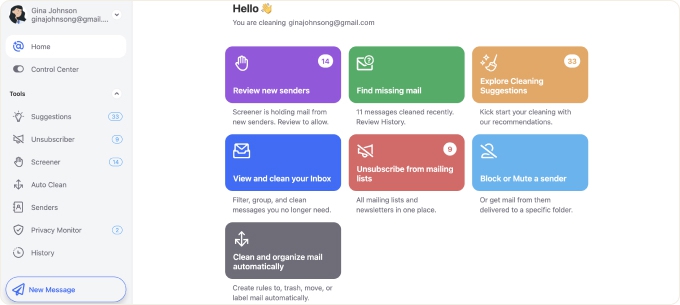
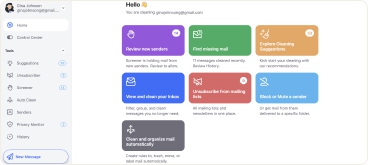
If you’re often sending out emails in bulk, you want to keep your inbox as clean as possible to reduce the risk of interacting with harmful messages that could damage your email’s credibility. This is where Clean Email’s Screener tool comes in handy.
Screener quarantines messages from unknown senders, letting you review and decide whether to block or allow them. This keeps your inbox free of unwanted or suspicious emails. By blocking spammy senders, Clean Email’s Screener helps protect your domain reputation.
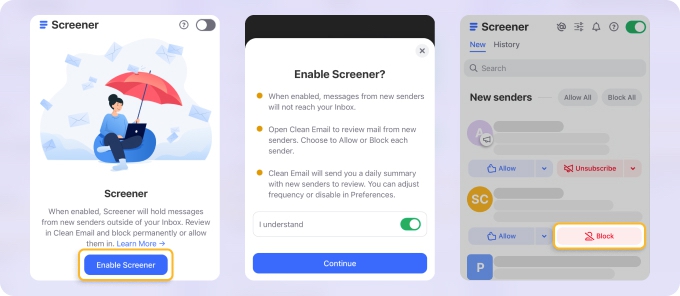

As we’ve already mentioned, you can also use Clean Email to get rid of all unwanted subscriptions, even if the senders have not included an unsubscribe link in the email body. That’s because Clean Email’s Unsubscriber feature can intelligently recognize different kinds of email subscriptions and show them all in one place.
It allows you to unsubscribe from multiple senders at once and instantly delete all emails from them if preferred.
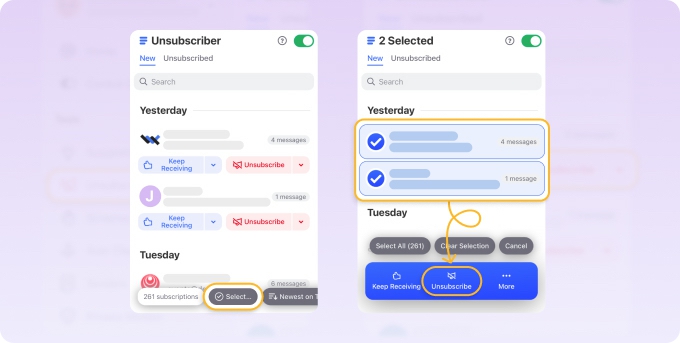
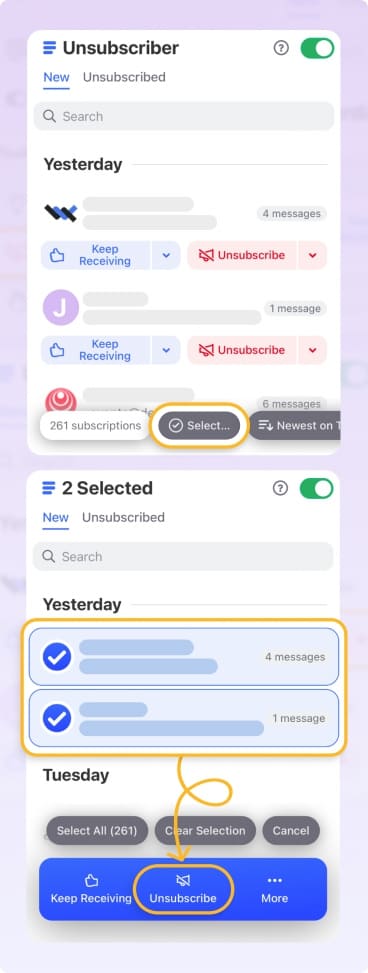
The Auto Clean feature simplifies inbox management by automatically applying actions like remove, archive, or move to bundles of emails instead of manually managing them individually. With customizable rules, it keeps your inbox organized, saves time, and ensures you don’t miss important messages.
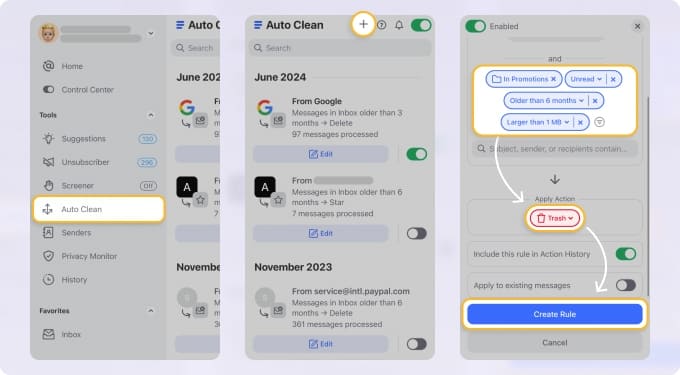

What to Do If Email Was Blacklisted?
If you suspect that your email got blacklisted, you should do a quick email blacklist check using an email blacklist checker, which is a software tool that allows you to easily check email blacklists with just a few clicks.
It’s much faster to use an email blacklist checker than it is to manually check individual blacklist email sites. All major blacklist checkers typically come with a plethora of other useful features to help you learn more about your email address and its status in the eyes of email and internet service providers.
How to Choose The Right Email Blacklist Checker
The right email blacklist checker depends on your specific needs and what kind of email address you’re using. There are two types of blacklist checkers: an email blacklist check and an IP blacklist lookup.
IP and Domain Lookup for Blacklists
Tools in this category are designed to check if specific domains or IP addresses are listed on blacklists. These tools are particularly useful for businesses and larger entities that operate dedicated email servers or manage custom domains.
These tools can check the entire domain or IP address and assess the likelihood of emails ending up on a blacklist or in recipients’ spam folders.
Email Blacklist Checker
The tools that fall under this category are geared towards checking individual email addresses. If your email is hosted on one of the most common email providers (Gmail, Outlook, etc.), this would be the best choice to check if your address is on an email spam list.
TOP 2 Tools to Check if Your Email Spam Listed
1. Spamhaus: fast check if your email spam listed
Spamhaus offers a quick and efficient way to check if your email is blacklisted. To get started, simply enter your email address into their system.

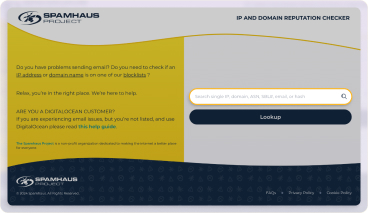
The tool doesn’t overwhelm you with unnecessary information—if your email isn’t blacklisted, it confirms the status without providing extraneous details.

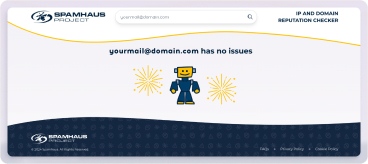
In addition to checking your email address, Spamhaus allows you to verify other identifiers such as your email server IP, domain, ASN, SBL#, or hash. This flexibility makes it a valuable resource for identifying and resolving potential issues that could impact email deliverability.
If you’re looking for a simple and hassle-free way to ensure your email isn’t flagged, Spamhaus is an excellent choice. It’s designed for quick results and keeps the process straightforward for users.
2. Mailgenius: detailed check with suggestions on improvements
With Mailgenius, you can copy a generated email address from the service’s homepage and use it as the recipient of your email. Once it goes through, the tool analyzes your email’s contents and provides feedback.
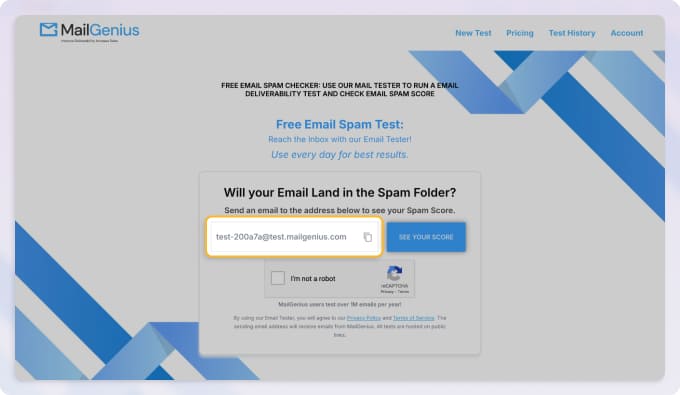

Mailgenius can scan through your email’s body and attachments, and it can analyze the subject line, preview text, and overall spam score. It can also show you a preview of how your email would appear on different devices.
Then, the tool provides you with a score that shows you how healthy your email is and if it can end up on a blacklist. Through this in-depth analysis of your email, you can mitigate the likelihood of having your email on a spam list.

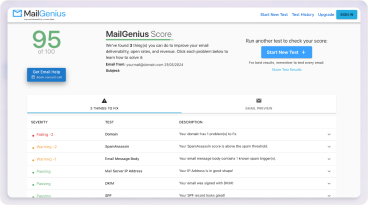
This is particularly useful if you have a history of your messages going straight to spam and want to avoid it moving forward. It’s also a useful tool to avoid getting your email spam listed before launching a mass email campaign.
TOP 3 Tools to Check if You’re Blacklisted by IP and Domain
Here are three public email blacklist checkers for businesses and private email servers you should know about:
1. MXToolBox
MXToolBox is a blacklist checker that tests a mail server IP address against over 100 DNS-based email blacklists
This is how you can check your email address with MXToolBox:
- Go to https://mxtoolbox.com/blacklists.aspx
- Enter your server IP or domain name and click the Blacklist Check button to perform an email blacklist check.
- After a few seconds, you should see a long list of popular email blacklists with status messages right next to them. If all blacklists display the “OK” message, your email address isn’t blacklisted.


You can then instruct MXToolBox to monitor your mail address and alert you if it ever gets blacklisted. As a free user, you can monitor one mail address and access troubleshooting information about backlist, email, DNS, & web issues.
To unlock more features, such as email delivery tracking, email performance monitoring, and real-time email reputation data, you need to purchase the Delivery Center service for $129/month.
MXToolBox also offers an enhanced version of the Deliver Center service for $399/month, called Delivery Center Plus. The enhanced version can process up to 5 million messages a month, and it includes alert integrations, advanced sender detail, and treat investigator.
2. DNSBL.info
DNSBL.info is a single place where you can check the blacklist status of your mail server's IP address on more than 100 DNS based blacklists. The service is owned and operated by CGP Holdings, a US-based company with 15+ years’ experience in developing dynamic content websites.
Performing a blacklist check on DNSBL.info is simple since all you need to do is enter the IP address you want to check into the Quick Blacklist Check field and click the Check This IP button next to it. What you want to see are green “Ok” labels next to all blacklists checked by DNSBL.info.
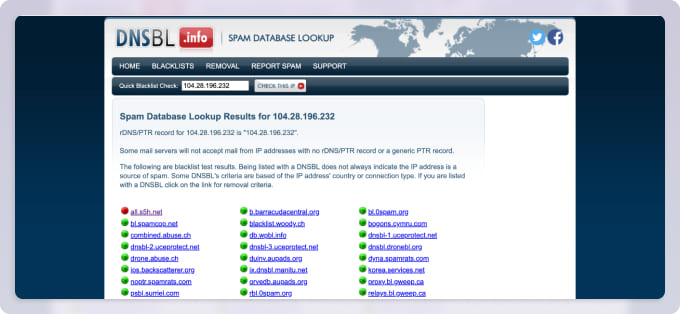
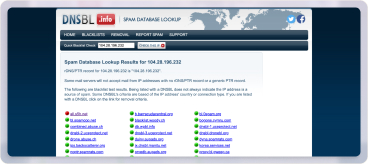
DNSBL.info states that simply being listed does not always indicate the IP address is a source of spam. That’s because the blacklist checker takes into consideration many different criteria, some of which are based on the IP address' country or connection type.
📌 Tip: To verify the result, we recommend you use at least one other blacklist checker.
3. Multirbl.valli.org
Multirbl.valli.org is a comprehensive blacklist email address checker that consults over 120 different email blacklist databases. The checker lets you perform FCrDNS and DNSBL lookups on IPv4/IPv6 addresses or domain names.

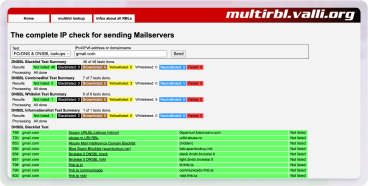
All checks are performed extremely quickly, and you don’t need to spend any money to unlock everything Multirbl.valli.org has to offer because this blacklist checker is completely free.
Email Blacklist Removal
Ending up on an email blacklist isn’t the end of the world. If you’ve found out that your email address has been blacklisted, you need to change what’s wrong and contact the spam list, telling them that the problem is now fixed.
Most spam list owners and administrators respond to removal requests fairly quickly, but we highly recommend you do everything you can to ensure that the problem has been fixed before you ask for your email address to be removed because they probably wouldn’t be so friendly the second time around.
In addition to cleaning up your email list, you should also scan your computer and other devices for malware and use an inbox cleaner like Clean Email to organize your inbox and remove all junk emails you don’t need. Clean Email can automatically unsubscribe you from all unwanted subscriptions and block spam senders with a few clicks.
Email Blacklist Databases
Online spam list checkers typically scan your email server or address against the 100 largest blacklist databases. Among the most well-known is the Composite Blocking List (CBL) by Spamhaus. According to its website, "the CBL lists IPs exhibiting characteristics specific to open proxies of various sorts and dedicated Spam BOTs that have been abused to send spam."
📌 Other prominent email blacklists include SpamCop, MultiRBL, SURBL, and Invaluement, just to name a few.
Conclusion
“Is my email blacklisted?” isn’t a difficult question to answer because there are many free email blacklist checkers that you can use to instantly see if your email address has ended up on an email blacklist. Of course, discovering that your email address has, indeed, been blacklisted is just the first step toward email blacklist removal (learn more about how to whitelist an email).
To successfully remove a blacklisted email address from all email blacklists, you need to change what’s wrong and contact the owners of the corresponding email blacklists. You should also verify that both your computer and your inbox are clean, which you can do using any popular malware removal tool and Clean Email, an easy-to-use inbox organizer.
Email Blacklist Check - FAQs
1. What does blacklisted mean?
When a mail address becomes blacklisted, it gets added to a database maintained either by an email service provider (such as Google, Yahoo, or Microsoft), or some third party. Service providers then check this blacklist to determine which messages to allow and which to place on an email blocklist.
2. How do emails get blacklisted?
Emails, or more specifically mail addresses, get blacklisted for a variety of different reasons, including hacking, spoofing, and, most importantly, distributing spam emails.
3. How do I check if my email is blacklisted?
There are many blacklist lookup websites that let you easily check if your email is blacklisted. Simply google “blacklist checker,” and you should instantly see several options right on the front page. Just keep in mind that not all blacklist checkers monitor the same email blacklists, so make sure to check multiple blacklists and not just one.
4. How do you get off the blacklist?
To get off an email blacklist, you need to address the original reason for blacklisting. For example, if your mail account got hacked and was used to distribute spam, then you need to change your password and preferably activate two-factor authentication to prevent unauthorized use of the mail address. You can then contact the administrators of the email blacklist and ask them to remove your address.
5. How many emails can I send without getting blacklisted?
Unfortunately, there’s no clear-cut answer to this question because there are many different IP blacklists, each with its own rules. Generally, you can send as many emails as you want, but the emails must be legitimate and sent only to recipients who have explicitly opted in to receive them.


